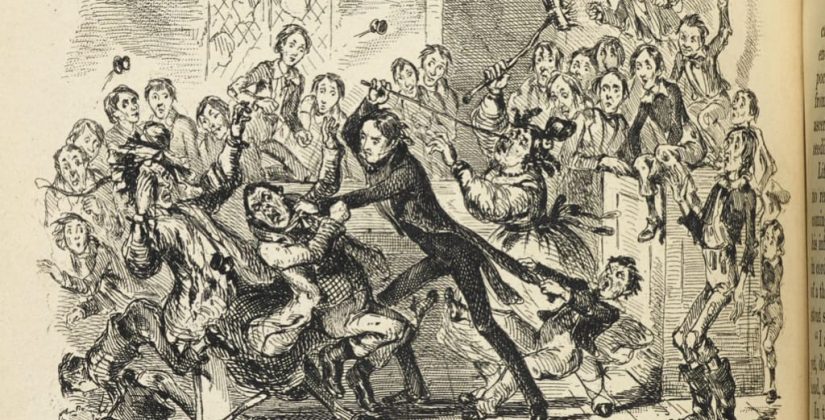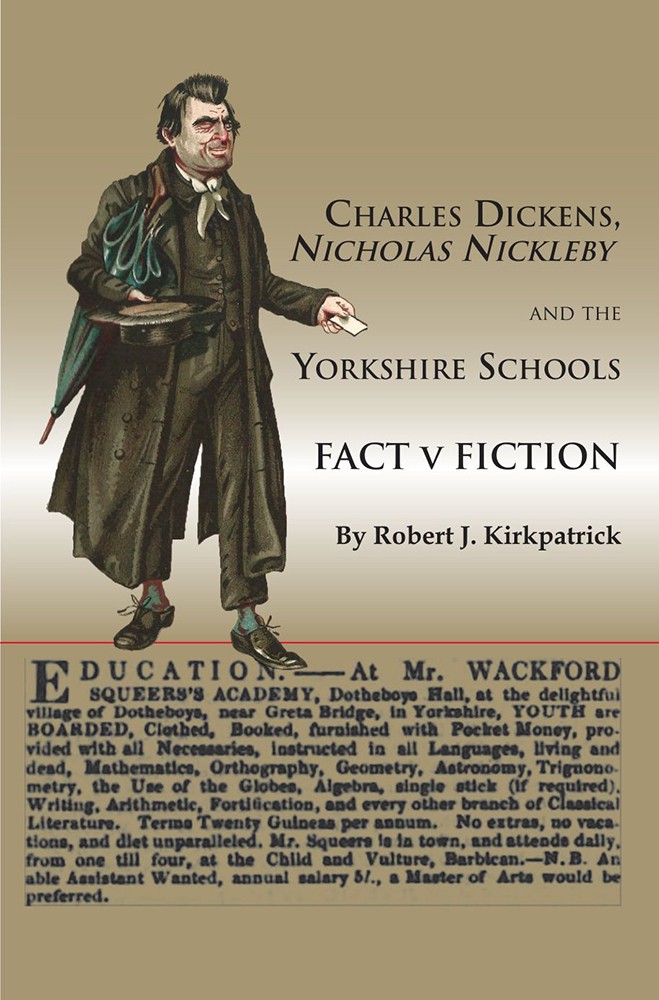Book review: Nicholas Nickleby and the Yorkshire Schools – fact v fiction, by Robert J Kirkpatrick
Paul Magrath on how two cases in the Court of Common Pleas inspired the fictional school scenes in Nicholas Nickleby, and the consequences of Dickens’s novel for the real school and its head.

Schools in court: a whacking good precedent
In 1832 the parents of boys sent to Bowes Academy, a school in Yorkshire, successfully sued its proprietor and headmaster, William Shaw, in two actions in the Court of Common Pleas claiming damages for gross neglect. The evidence in the cases almost certainly inspired the notorious fictional school of Dotheboys Hall and its headmaster, Wackford Squeers, created by Charles Dickens in the novel Nicholas Nickleby. Although Dickens himself disavowed the connection, the assumption that Squeers was based on Shaw, and Dotheboys on Bowes, proved fatal to the latter establishment, which closed not long after the novel was published.
The relationship of the fiction to the fact on which is was said to have been based has been explored, and relevant material collected together in a new book by Robert J Kirkpatrick, an expert on boys’ school stories. Charles Dickens, Nicholas Nickleby and the Yorkshire Schools: fact v fiction (Mosaic, £18) is fascinating both as a study of Dickens’s work and working methods, but also of the private schools of the early 19th century, some of which seem to have been little better than detention centres for unwanted children.
The Yorkshire schools
Dickens wrote Nickleby in the late 1830s but it is set more than a decade earlier, before the advent of railway travel, at a time when Yorkshire still seemed legendarily remote from London and the south east. The private schools which flourished there did so, in part, because they were places of banishment to which children who were an inconvenience to their parents or guardians could safely be sent, as much to get them out of the way, as to prepare them for adult life. Advertisements for the schools, while boasting with customary hyperbole of their salubrious conditions and pedagogic virtues, invariably also pointed out that they allowed “no vacations” to hinder the progress of the boys’ education. Some of the descriptions in memoirs of the time paint as dire a picture as the satire of Nicholas Nickleby, but there was other evidence to suggest that these private schools were not nearly as bad as Dickens described, and in some ways offered a more rounded education than the famous public schools in whose shadow (though at much cheaper cost) they operated.
The schools were still very much in operation when Dickens made a trip to Yorkshire, by stagecoach, to visit them in 1838. Among those he visited was Bowes Hall Academy, near Greta Bridge in the North Riding of Yorkshire, which was run by William Shaw, who had achieved some notoriety in 1823 when he was sued by two sets of parents for negligence.
Jones v Shaw
The first case was reported extensively in The Times, as seems to have been regular practice in those days, with much of the evidence being recorded almost verbatim. It is hard to imagine the press devoting so much space or indeed anything like the same attention to legal proceedings nowadays, unless they happen to involve celebrities or lend themselves to some form of sensationalisation.
It does not appear that the case was ever reported more formally in the law reports of the time, as one might have expected if any point of principle had been at issue. Neither the Law Journal reports nor Bingham’s cases, which cover the Common Pleas division, contains any reference to the case. Coverage was haphazard at the time, and first instance (or nisi prius) cases mainly depending on questions of fact to be determined by a jury would probably not justify reporting.
The hearing of Jones v Shaw took place before Mr Justice Park in the Court of Common Pleas sitting at the Guildhall, London on 30 October 1823. The plaintiff’s sons, Richard and William, entered Bowes Academy in October 1819, aged ten and just under eight respectively. Over the next two years both boys developed problems with their eyes, which the school concealed from their parents, and by March 1821 one of them, William, had gone quite blind. The evidence they and other witnesses gave suggested a very poor level of hygiene in the school and lack of medical attention to eye infections, though there was also evidence to the contrary. Nevertheless, after retiring for only half an hour, the jury returned with a verdict for Mr Jones, who was awarded damages of £300.
Ockerby v Shaw
The second case, brought by a Mr Ockerby, also involved damage to the eyes suffered by three sons whom he had sent to the school in 1820. It was heard the following day in the same court, and reported briefly in The Times, more fully in the Morning Advertiser. There was similar evidence of poor hygiene and medical neglect, but this time the case did not get near the jury because the defendant conceded defeat and offered to settle for damages similar to those awarded to Mr Jones. Mr Justice Park “commended the discretion of counsel”.
Kirkpatrick notes that the eye infection suffered by the boys was probably trachoma, and liable to be spread by direct and indirect contact, such as overcrowding and sharing communal towels for washing, as had emerged from the evidence. This may not have been commonly known and although better hygiene might have mitigated the extent of the outbreak “it could be argued that, in the circumstances, Shaw and his staff did all that could reasonably have been expected of them”. He also notes that only two sets of parents took legal action, suggesting many of the others infected in the outbreak may have been orphaned or illegitimate, with no one to take up their cases.
Fact v fiction
Dickens made his trip to Yorkshire to see Bowes Academy and other schools in 1838. It seems he only spent a couple of days there, and was not made welcome by Shaw. In the preface to Nicholas Nickleby, Dickens claims to have received accounts from reliable sources to support his condemnation of the “Yorkshire schools” exemplified in his fictional treatment, but he seems to have derived much of his information from reports of the evidence given in the two court cases from 1823.
Kirkpatrick examines the myths and debunks them to some extent. Dotheboys Hall is not Bowes Academy and Wackford Squeers is not Mr Shaw. Dickens almost certainly relied on the court reports of the cases against Mr Shaw, but his fictional school is both a composite and an exaggeration.
In place of the myths, Kirkpatrick presents a comprehensive history of the Yorkshire schools, based on all the available evidence, including memoirs, biographies, letters and, revealingly, the advertisements put out by the schools themselves, as well as examining key passages in the novel itself. In so doing he aims to present in one place a “fuller and more balanced picture of the Yorkshire schools”, free from the “dogmatism and bias that has typified many previous studies”.
He has certainly done a thorough job, and for anyone with the stomach and curiosity to delve into the topic in detail, there is plenty here to feed on. It must also be of interest to social historians and those, like Kirkpatrick himself, who are interested in the cultural phenomenon of the British boarding school and its development from the mid-18th to the late 19th centuries. It is a phenomenon that has inspired a lot of other writers, and a popular fictional genre. Unfortunately, it also continues to provide material for the law courts and other forms of legal scrutiny.

Robert J Kirkpatrick, Charles Dickens, Nicholas Nickleby and the Yorkshire Schools: fact v fiction (Mosaic, £18)
Further reading:
John Sutherland (via British Library): Nicholas Nickleby and the Yorkshire schools
Researchers Plus: William Shaw and Bowes Academy